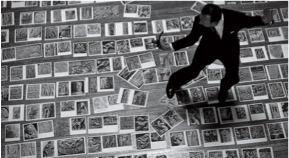Public Art on Campus - Dennis Adams
ART ON CAMPUS
Title: Komatic Trophy
Year: 1974
Medium: Wood, acrylic, yarn
Location: Education Building, North Stairwell
Gift of Rob Clark and Jerry Thacker
“Komatic Trophy” is a very early sculptural work made when Dennis Adams was a young professor at Wright State University in Dayton, Ohio. It is one of several handmade sleds created for a 1975 exhibition entitled “Sleds, Signs and Repairs.” The title of this sculpture refers to an Inuit type of sled used to travel on snow and ice. Typically, the wooden runners and crossbars of a komatic are lashed together with rawhide. In Adams’ version, the crossbars appear to be held together with yarn and beads. The three-dimensional structure is hand painted with bright colors, and even includes trompe l’oil knot holes. It was constructed at an angle so that it appears to be racing down a slope when installed on a wall
In response to a 2021 email requesting information about the sculpture, Adams responded:
It was an attempt to bring my first works in photography and text together with my sculptural works. The sleds represent the conditions of memory. One of them was even called ROSEBUD after Orson Welles’ most famous line [a reference from the 1941 film Citizen Kane]. I remember adding this word “Repairs” to the title to suggest some kind of back-peddling in the act of making art. Perhaps—a kind of delay to slow down time—a self-consciousness of sorts. I was a kid pressing all the buttons!
In graduate school in Philadelphia, Adams had been exposed to a forward-thinking curriculum addressing the role of art in society, and at Wright State was introduced to the work of cutting-edge artists like Robert Irwin who created site specific installations using light and space. Adams himself was beginning to push the boundaries on what art is and can be. He states that he was beginning to make art with multiple levels of meaning during this time. “It has been an obsession from the beginning. In fact, I was reading Finnegan’s Wake at the exact moment I was working on those pieces. Shortly after, I did a large installation of photographs taken from the pages of Joyce’s book as my hands performed on top of them.”
A review of the sled exhibition appeared in the January 13, 1975 Wright State Guardian newspaper. Although written in a flippant manner by Nathan Schwartz, it does provide an interesting visual description of the exhibition, as well as an honest reaction from someone with little affinity for non-traditional artforms:
…the show Sleds and signs and repairs and photographs and tents. Childhood revisited, larger than life. Rosebud. Hannibal. Citizen Kane and Xanadu and long lost sleds. Drawings of sleds. They have shapes of states for surface instead of wood. The country’s going downhill? Tents, or rather tent. On the wall. Green. With a sled. Camping and sledding. Remember the speed and the cold. Suicide hill and broken bones. A sled bound with plastic tubing filled with red liquid. Kool Aid? And seeds and grains. The breakfast of champions? Rosebud again.
The reviewer’s satire apparently did little to unsettle Adams. The same exhibition was shown at Carl Solway Gallery in Cincinnati where this particular sled was sold. From there, Adams went on to become an internationally recognized artist in high demand for art exhibitions, public art installations and teaching positions.




